Synthesis, Characterization, and Crystal Structure of a Triazine Anion Pentafluoroosmium(VI) Complex
Abstract
:1. Introduction
2. Materials and Methods
3. Results and Discussion
3.1. Synthesis of 1
3.2. Molecular Structure
3.3. Crystal Packing
4. Conclusions
Acknowledgments
Author Contributions
Conflicts of Interest
References
- Khanfar, M.A.; Seppelt, K. Fluorinated benzene cations. J. Fluor. Chem. 2015, 179, 193–197. [Google Scholar] [CrossRef]
- Shorafa, H.; Mollenhauer, D.; Paulus, B.; Seppelt, K. The two structures of the hexafluorobenzene radical cation C6F6+. Angew. Chem. Int. Ed. 2009, 48, 5845–5847. [Google Scholar] [CrossRef] [PubMed]
- Chen, X.; Wang, X.; Sui, Y.; Li, Y.; Ma, J.; Zuo, J.; Wang, X. Synthesis, characterization, and structures of a persistent aniline radical cation. Angew. Chem. Int. Ed. 2012, 51, 11878–11881. [Google Scholar] [CrossRef] [PubMed]
- Marchetti, F.; Pinzino, C.; Zacchini, S.; Pampaloni, G. Long-Lived radical cations of monocyclic arenes at room temperature obtained by nbf5 acting as an oxidizing agent and counterion precursor. Angew. Chem. Int. Ed. 2010, 49, 5268–5272. [Google Scholar] [CrossRef] [PubMed]
- Marchetti, F.; Pampaloni, G.; Pinzino, C. Room-temperature long-lived [Nb2F11]− salts of radical cations of simple arenes: EPR, UV–Vis and DFT results. J. Organomet. Chem. 2011, 696, 1294–1300. [Google Scholar] [CrossRef]
- Mallow, O.; Khanfar, M.A.; Malischewski, M.; Finke, P.; Hesse, M.; Lork, E.; Augenstein, T.; Breher, F.; Harmer, J.R.; Vasilieva, N.V. Diaryldichalcogenide radical cations. Chem. Sci. 2015, 6, 497–504. [Google Scholar] [CrossRef] [PubMed]
- Tjahjanto, R.T.; Peintinger, M.F.; Bredow, T.; Beck, J. The Reactions of Thianthrene and selenanthrene with alcl3: coordination complexes, radical ions, and investigations on the unique triple-decker molecule (Thianthrene)32+. Eur. J. Inorg. Chem. 2012, 3625–3635. [Google Scholar] [CrossRef]
- Poleschner, H.; Seppelt, K. XeF2/Fluoride acceptors as versatile one-electron oxidants. Angew. Chem. Int. Ed. 2013, 52, 12838–12842. [Google Scholar] [CrossRef] [PubMed]
- Spurg, A.; Schnakenburg, G.; Waldvogel, S.R. Oxidative coupling of diaryldisulfides by MoCl5 to thianthrenes. Chem. Eur. J. 2009, 15, 13313–13317. [Google Scholar] [CrossRef] [PubMed]
- Berger, R.; Resnati, G.; Metrangolo, P.; Weber, E.; Hulliger, J. Organic fluorine compounds: A great opportunity for enhanced materials properties. Chem. Soc. Rev. 2011, 40, 3496–3508. [Google Scholar] [CrossRef] [PubMed]
- Merkel, L.; Budisa, N. Organic fluorine as a polypeptide building element: In vivo expression of fluorinated peptides, proteins and proteomes. Org. Biomol. Chem. 2012, 10, 7241–7261. [Google Scholar] [CrossRef] [PubMed]
- Vincent, J.-M. Recent advances of fluorous chemistry in material sciences. Chem. Commun. 2012, 48, 11382–11391. [Google Scholar] [CrossRef] [PubMed]
- Wang, C.; Danovich, D.; Mo, Y.; Shaik, S. On the nature of the halogen bond. J. Chem. Theory Comput. 2014, 10, 3726–3737. [Google Scholar] [CrossRef] [PubMed]
- Mukherjee, A.; Tothadi, S.; Desiraju, G.R. halogen bonds in crystal engineering: like hydrogen bonds yet different. Acc. Chem. Res. 2014, 47, 2514–2524. [Google Scholar] [CrossRef] [PubMed]
- Rybalova, T.; Bagryanskaya, I.Y. C–F···π, F···H, and F···F intermolecular interactions and F-Aggregation: Role in crystal engineering of fluoroorganic compounds. J. Struct. Chem. 2009, 50, 741–753. [Google Scholar] [CrossRef]
- Osuna, R.M.; Hernández, V.; Navarrete, J.T.L.; D’Oria, E.; Novoa, J.J. Theoretical evaluation of the nature and strength of the F···F intermolecular interactions present in fluorinated hydrocarbons. Theor. Chem. Acc. 2010, 128, 541–553. [Google Scholar] [CrossRef]
- Espallargas, G.M.; Brammer, L.; Sherwood, P. Designing intermolecular interactions between halogenated peripheries of inorganic and organic molecules: electrostatically directed M–X···X′–C halogen bonds. Angew. Chem. Int. Ed. 2006, 45, 435–440. [Google Scholar] [CrossRef] [PubMed]
- Espallargas, G.M.; Zordan, F.; Marín, A.L.; Adams, H.; Shankland, K.; van de Streek, J.; Brammer, L. Rational modification of the hierarchy of intermolecular interactions in molecular crystal structures by using tunable halogen bonds. Chem. Eur. J. 2009, 15, 7554–7568. [Google Scholar] [CrossRef] [PubMed]
- Bui, T.T.T.; Dahaoui, S.; Lecomte, C.; Desiraju, G.R.; Espinosa, E. The Nature of Halogen···Halogen interactions: A model derived from experimental charge-density analysis. Angew. Chem. Int. Ed. 2009, 48, 3838–3841. [Google Scholar] [CrossRef] [PubMed]
- Reddy, V.P.; Bellew, D.R.; Prakash, G.K.S. A convenient preparation of sulfuryl chloride fluoride. J. Fluor. Chem. 1992, 56, 195–197. [Google Scholar] [CrossRef]
- Drews, T.; Supeł, J.; Hagenbach, A.; Seppelt, K. Solid state molecular structures of transition metal hexafluorides. Inorg. Chem. 2006, 45, 3782–3788. [Google Scholar] [CrossRef] [PubMed]
- Veith, M.; Bärnighausen, H. Die Kristall- und Molekülstruktur von Bis(trimethylsilyl)diimin. Acta Cryst. 1974, 30, 1806–1813. [Google Scholar] [CrossRef]
- Sheldrich, G.M. A short history of SHELX. Acta Cryst. 2008, 64, 112–122. [Google Scholar] [CrossRef] [PubMed]
- Sheldrich, G.M. Crystal structure refinement with SHELXL. Acta Cryst. 2015, 71, 3–8. [Google Scholar]
- Chambers, R.D.; Philpot, P.D.; Russell, P.L. Reactions involving fluoride ion. Part 14. Anionic σ-complexes from polyfluorinated s-triazines. J. Chem. Soc. Perkin Trans. 1977, 1, 1605–1608. [Google Scholar] [CrossRef]
- Kingston, M.; Chen, S.-J.; Lork, E.; Mews, R. Anionic triazine systems. Dalton Trans. 2004, 9, 1400–1404. [Google Scholar] [CrossRef] [PubMed]
- Seppelt, K. Molecular Hexafluorides. Chem. Rev. 2015, 115, 1296–1306. [Google Scholar] [CrossRef] [PubMed]
- Craciun, R.; Picone, D.; Long, R.T.; Li, S.; Dixon, D.A.; Peterson, K.A.; Christe, K.O. Third row transition metal hexafluorides, extraordinary oxidizers, and lewis acids: electron affinities, fluoride affinities, and heats of formation of WF6, ReF6, OsF6, IrF6, PtF6, and AuF6. Inorg. Chem. 2010, 49, 1056–1070. [Google Scholar] [CrossRef] [PubMed]
- Martínez Casado, F.J.; Ramos Riesco, M.; Redondo, M.I.; Choquesillo-Lazarte, D.; López-Andrés, S.; Rodríguez Cheda, J.A. Anhydrous lithium acetate polymorphs and its hydrates: Three-dimensional coordination polymers. Cryst. Growth Des. 2011, 11, 1021–1032. [Google Scholar] [CrossRef]
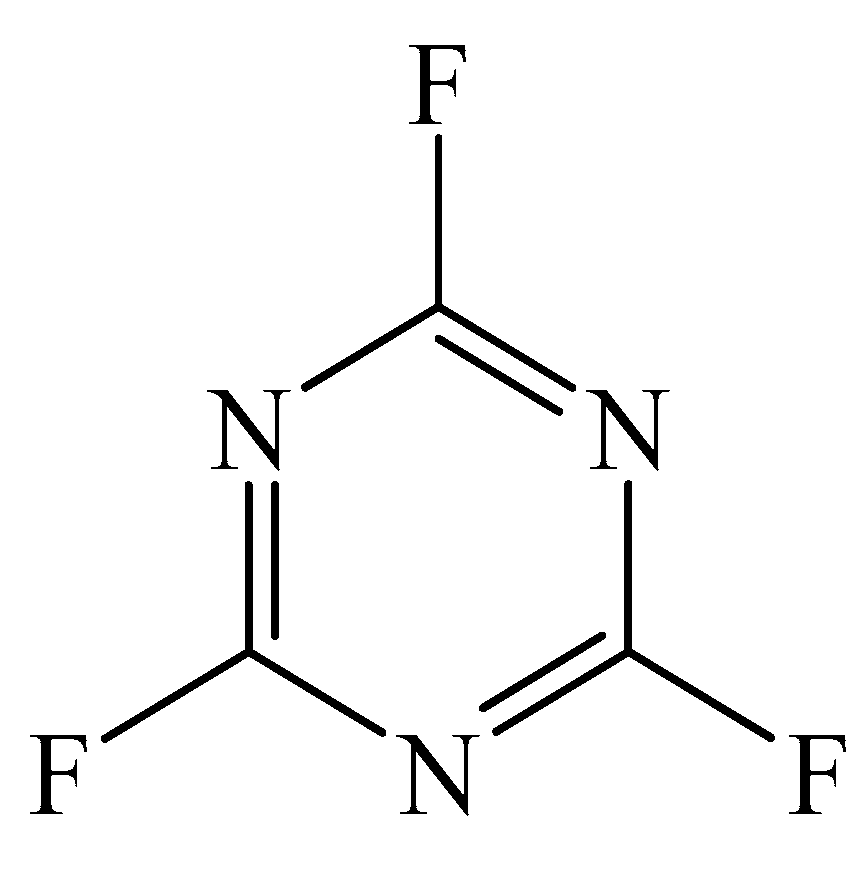
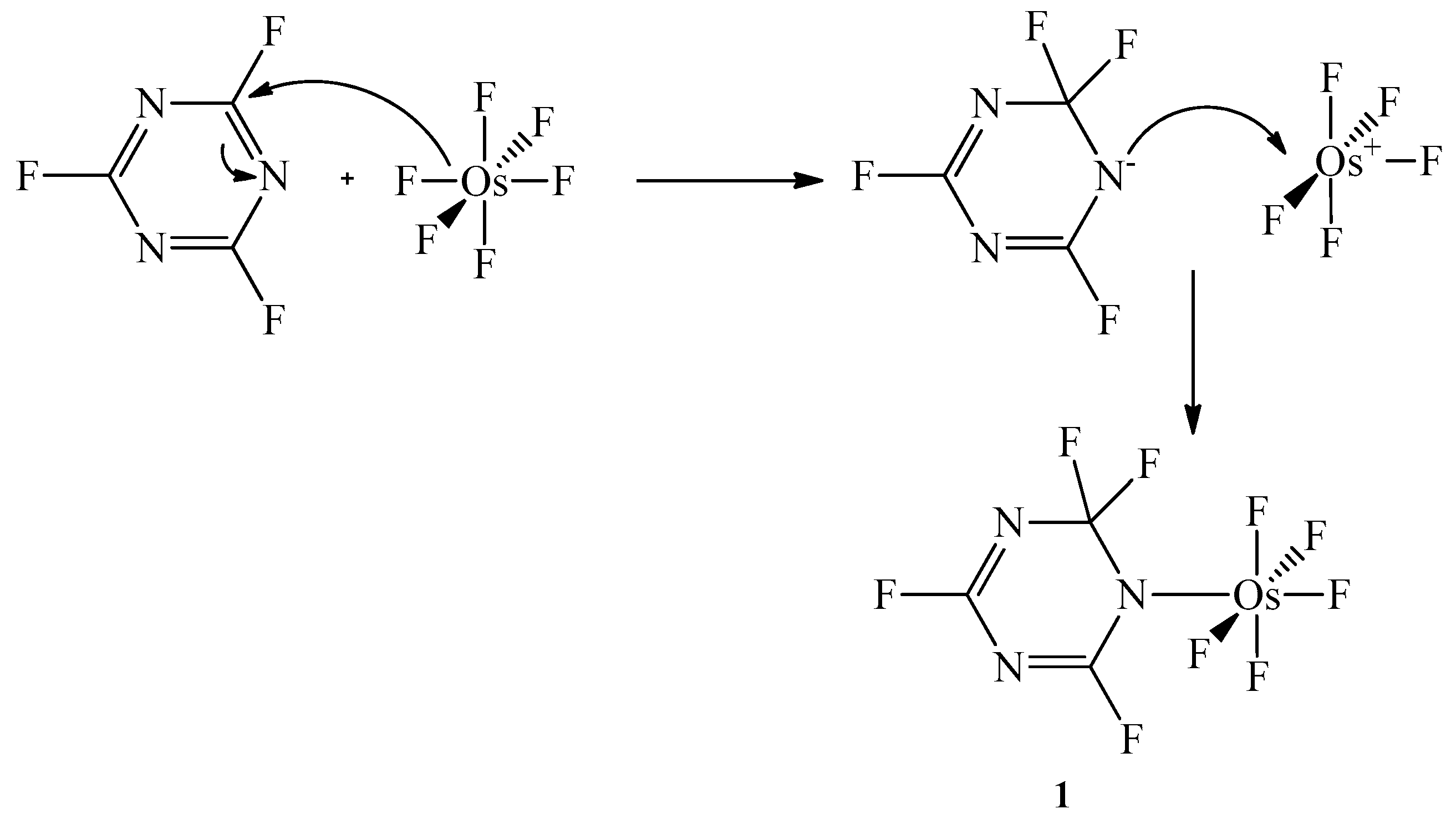
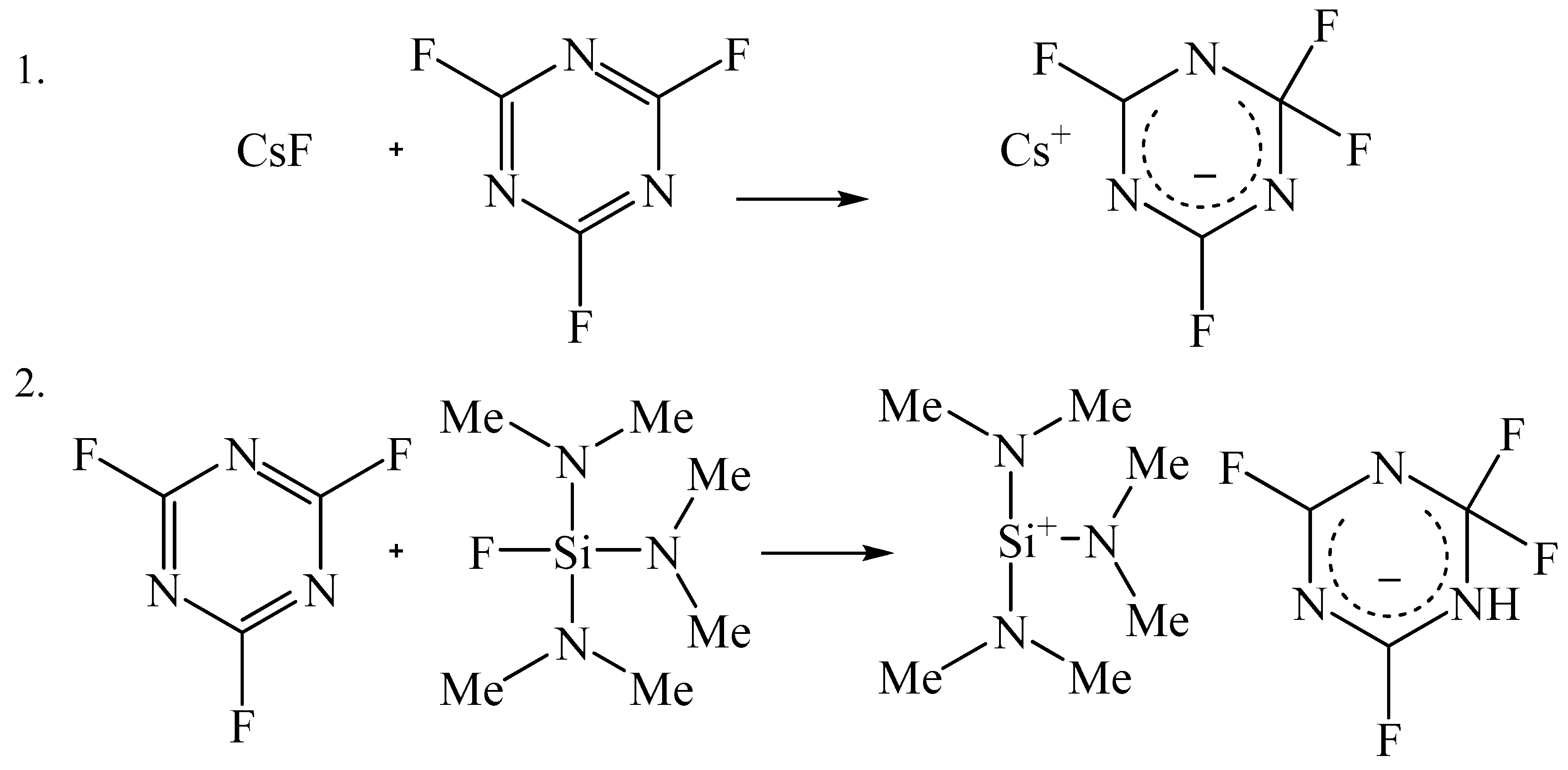
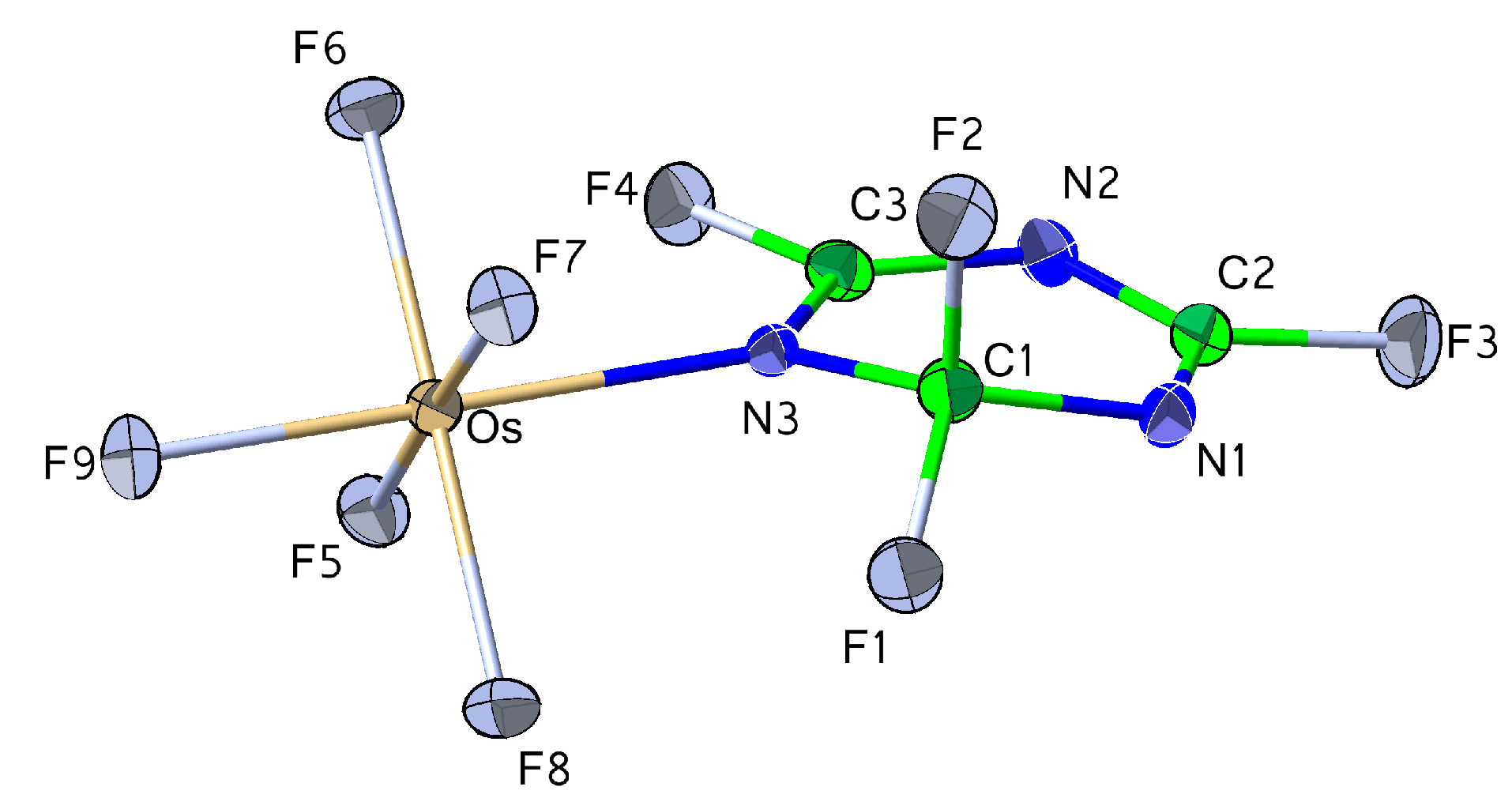

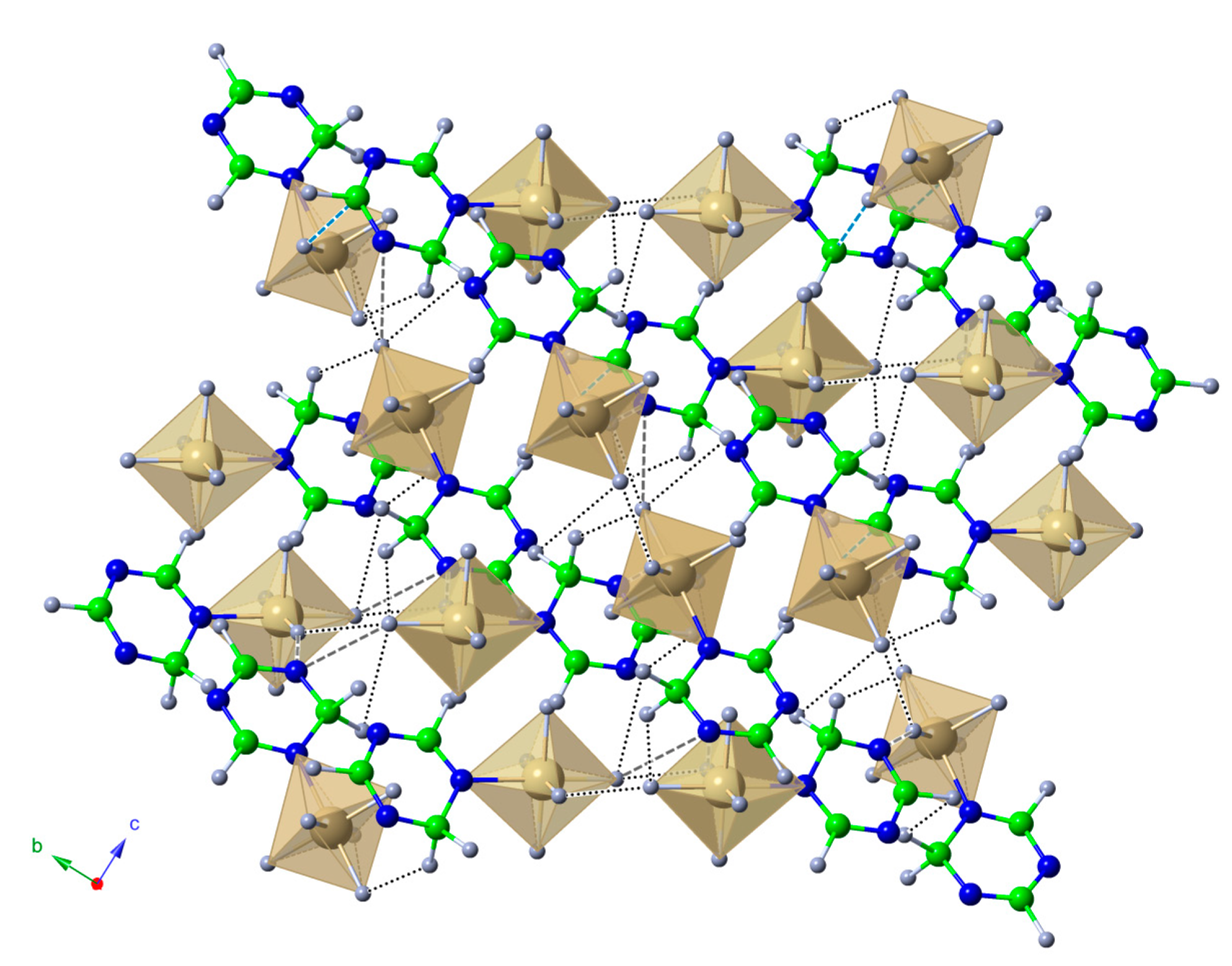
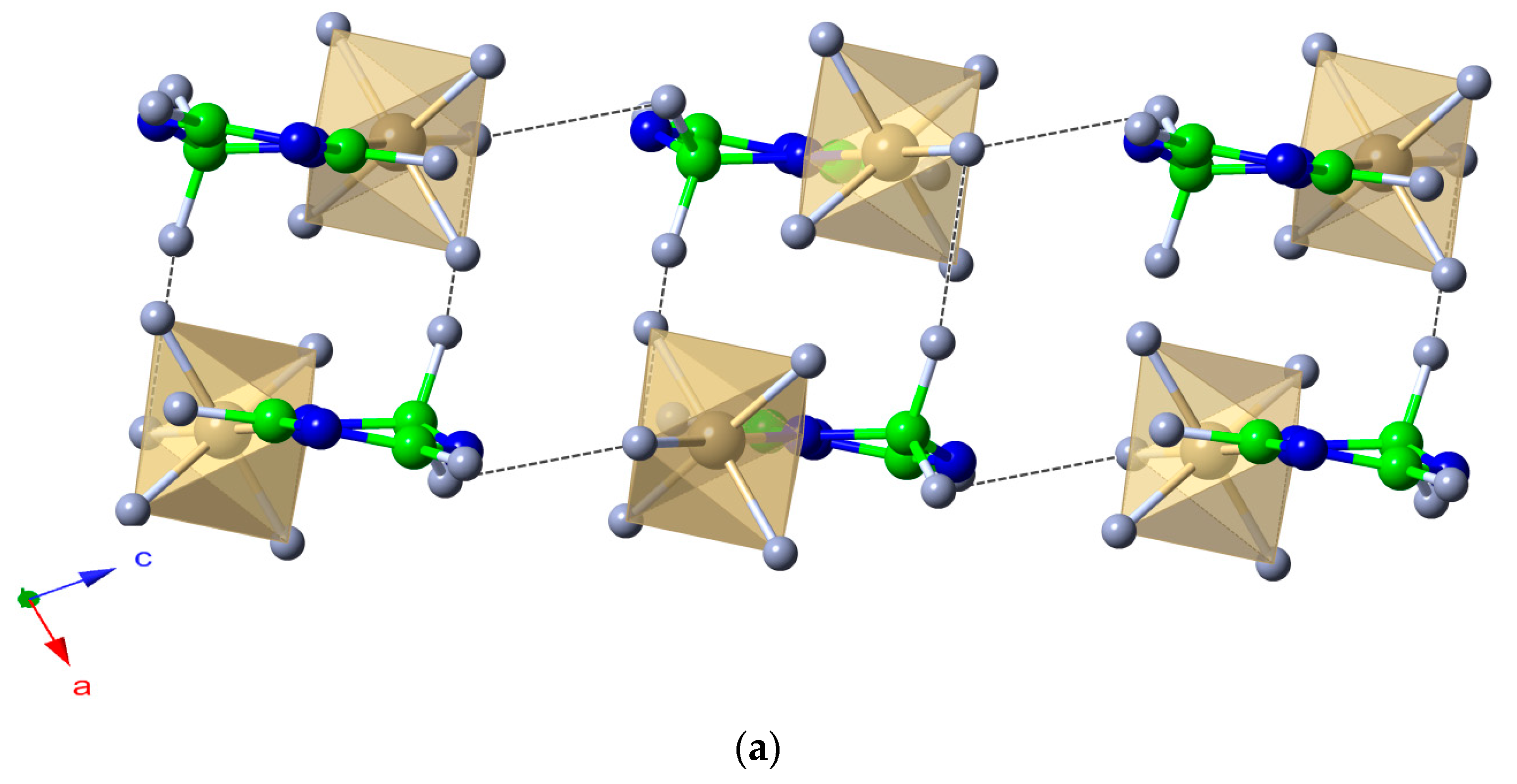
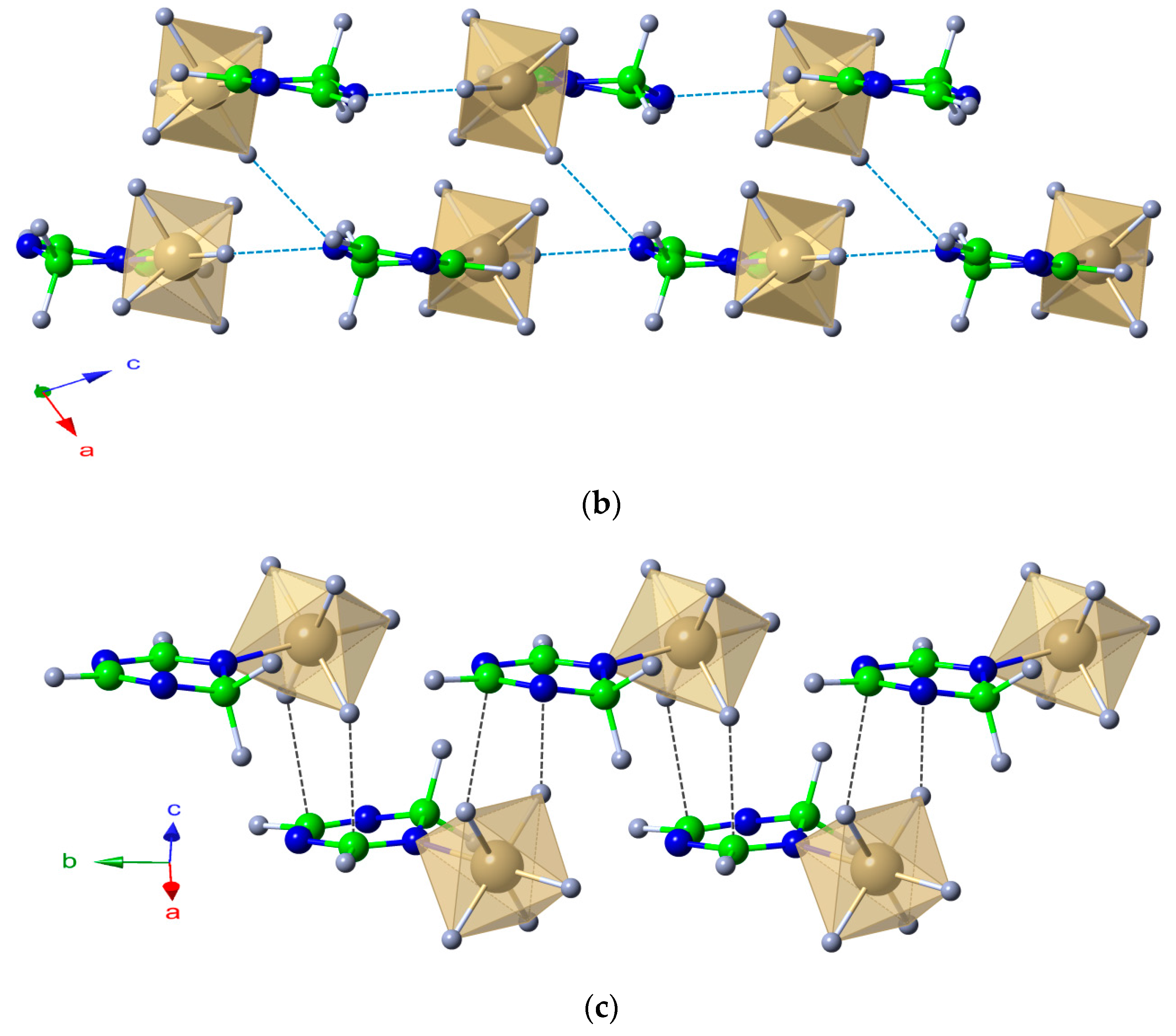
| CCDC Deposition Number | 1508189 |
|---|---|
| Empirical formula; formula weight | C3F4N3OsF5; 439.26 |
| Temperature (K) | 133(2) |
| λ (Å) | 0.71073 |
| Crystal system; space group | Monoclinic; P21/n |
| Unit cell dimensions | a = 8.6809(17) Å b = 7.6848(15) Å c = 12.415(3) Å β = 102.633(4)° |
| V (Å3) | 808.2(3) |
| Z | 4 |
| Dcalc. (Mg/m3) | 3.610 |
| Absorption coefficient (mm−1) | 15.93 |
| F(000) | 781 |
| Crystal size (mm3) | 0.2 × 0.1 × 0.1 |
| Theta range for data collection | 2.6° to 30.6° |
| Limiting indices | −11 ≤ h ≤ 12, −8 ≤ k ≤ 10, −17 ≤ l ≤ 17 |
| Reflections collected | 12782 |
| Completeness to theta = 25.125° | 99.8% |
| Independent reflections | 2474 (R(int) = 0.023) |
| Observed reflections | 2140 (II > 2(I)) |
| Reflections used for refinement | 2474 |
| Refinement method | Full-matrix least-squares on F2 |
| Data/restraints/parameters | 2474/0/145 |
| Goodness-of-fit on F2 | 1.052 |
| R values (I > 2sigma(I)) | R1 = 0.0152, wR2 = 0.0356 |
| R values (all data) | R1 = 0.0199, wR2 = 0.0374 |
| Largest difference electron densities | 1.01 and −1.01 e·Å−3 |
| Bond Distances | Os–F Complex a | Os–Faverage Complex |
|---|---|---|
| Os–F | 1.8696(17) 1.8661(17) 1.8638(17) 1.8687 (17) 1.8686(17) | 1.825 b; 1.857 c |
| Os–N3 | 2.078(2) a | |
| C3N3F4− anion a | C3N3F4− anion d | |
| C1–F1 | 1.332(3) | 1.400(4) |
| C1–F2 | 1.351(3) | 1.383(4) |
| C1–N1 | 1.422(4) | 1.403(4) |
| C1–N3 | 1.445(4) | 1.400(4) |
| N1–C2 | 1.316(4) | 1.277(4) |
| N2–C3 | 1.319(4) | 1.319(4) |
| N3–C3 | 1.320(4) | 1.279(4) |
| C2–N2 | 1.305(4) | 1.329(4) |
| C2–F3 | 1.297(3) | 1.345(3) |
| C3–F4 | 1.298(3) | 1.348(3) |
| N1–C1–N3 | 112.8(2) | 120.4(3) |
| N1–C2–N2 | 126.7(3) | 132.0(3) |
| F4–C3–N2 | 115.3(2) | 113.3(3) |
| N2–C3–N3 | 128.9(3) | 132.2(3) |
| F4–C3–N3 | 115.8(2) | 114.4(3) |
| F1–C1–F2 | 105.3(2) | 101.1(2) |
| F···F interactions | F···F | –F···X– |
|---|---|---|
| C1–F1···F3i–C2 i | 2.834 | 87, 114 |
| Os–F1···F9ii—C1 ii | 2.840 | 88, 106 |
| Os–F9···F2 iii–C1 iii | 2.873 | 143, 102 |
| Os–F8···F9iv–Os iv | 2.887 | 130, 137 |
| F···N interactions | F···N | –F···N |
| Os–F9···N1 v | 2.771 | 153 |
| Os–F8···N1 i | 2.857 | 165 |
| F···C interactions | F···C | –F···C– |
| Os–F7···C3 iii | 2.770 | 139, 91 |
| Os–F6···C2 iii | 2.771 | 128, 84 |
© 2018 by the authors. Licensee MDPI, Basel, Switzerland. This article is an open access article distributed under the terms and conditions of the Creative Commons Attribution (CC BY) license (http://creativecommons.org/licenses/by/4.0/).
Share and Cite
Khanfar, M.A.; Ali, B.F.; Shorafa, H.; Seppelt, K. Synthesis, Characterization, and Crystal Structure of a Triazine Anion Pentafluoroosmium(VI) Complex. Crystals 2018, 8, 63. https://doi.org/10.3390/cryst8020063
Khanfar MA, Ali BF, Shorafa H, Seppelt K. Synthesis, Characterization, and Crystal Structure of a Triazine Anion Pentafluoroosmium(VI) Complex. Crystals. 2018; 8(2):63. https://doi.org/10.3390/cryst8020063
Chicago/Turabian StyleKhanfar, Monther A., Basem F. Ali, Hashem Shorafa, and Konrad Seppelt. 2018. "Synthesis, Characterization, and Crystal Structure of a Triazine Anion Pentafluoroosmium(VI) Complex" Crystals 8, no. 2: 63. https://doi.org/10.3390/cryst8020063
APA StyleKhanfar, M. A., Ali, B. F., Shorafa, H., & Seppelt, K. (2018). Synthesis, Characterization, and Crystal Structure of a Triazine Anion Pentafluoroosmium(VI) Complex. Crystals, 8(2), 63. https://doi.org/10.3390/cryst8020063





